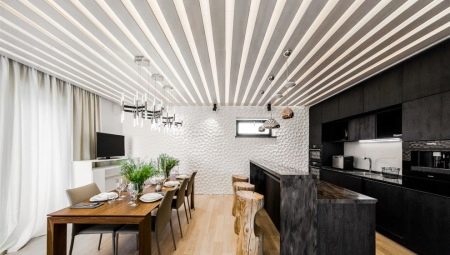Panels are a universal finishing material and allow you to quickly and inexpensively repair the ceiling in the kitchen. Thanks to the lengthy execution of the lamellae, installation can be done in a short time and without much labor.
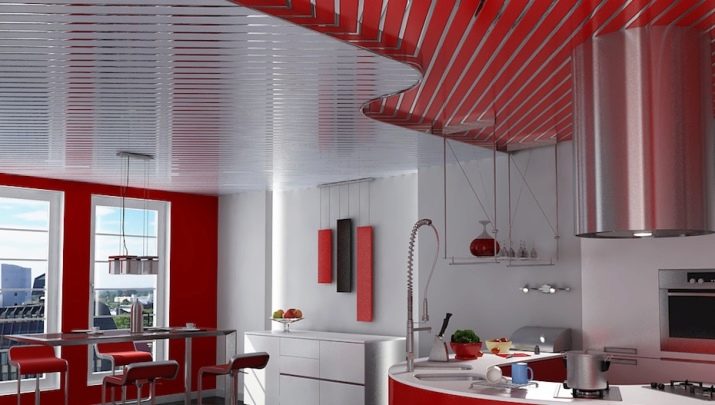
Panel Features
The facing materials that are used in the kitchen are subject to special requirements. This is due to increased humidity and high temperatures in the working area, as well as the presence of soot and greasy spray. These factors are present in varying degrees in every kitchen and adversely affect the appearance of ceiling coatings. In this regard, the material that will be lined with the ceiling must have high moisture resistance and fire safety, have a long service life and be easy to maintain.
In addition, it is desirable that it has an attractive appearance and is easy to install. Ceilings made of panels meet all these requirements. They have high performance, are very inexpensive and look great in the interior.
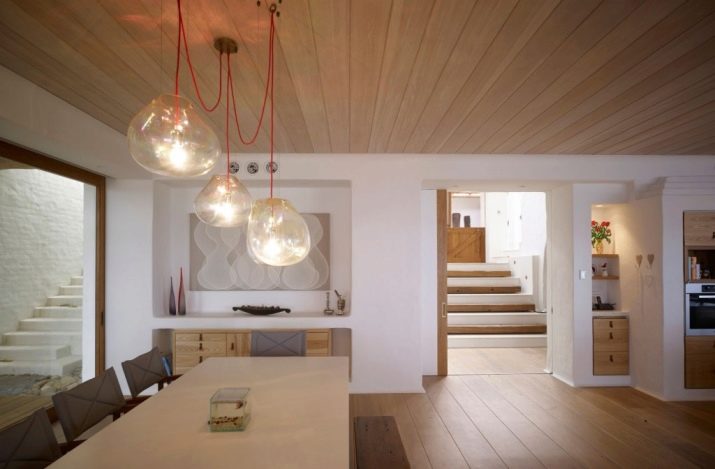
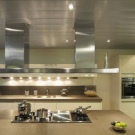
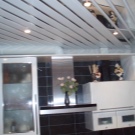
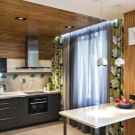
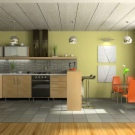

Advantages and disadvantages
Paneling the ceiling is considered a fairly popular type of decorative decoration. due to a number of undeniable advantages of this design.
- Simplicity and high speed of installation allow you to update the kitchen ceiling yourself and in a short time.
- Compared to other decorative coatings panels are sold at a very affordable price and are characterized by wide consumer availability.
- A huge range of slats with a wide variety of textures and designs greatly facilitates the selection and allows you to purchase material for any style and color.
- The surface of the panels contains a minimum number of pores., because of which it has high moisture repellent properties and is not afraid of steam and drops of fat. It is very easy to wash such a ceiling, and any liquid product is suitable for processing.
- Due to smooth and hard surface panel ceilings are not afraid of the appearance of mold and fungus, as harmful bacteria simply have nowhere to settle.
- One of the options for decorating ceilings their decoration is ordinary wall panels. They are equipped with a convenient comb-groove lock, which allows you to assemble the surface like a puzzle.
- For mounting a panel structure, a frame is required, thanks to which space is formed between the floor slab and the suspended lamellas. This allows you to hide all communications in it and makes it possible to hide defects and irregularities in concrete or wooden ceilings. Moreover, the presence of an air gap has a good soundproofing effect, which is especially true in multi-apartment buildings.
- Unlike stretch ceilings structures made of PVC panels are not afraid of floods from above and with moderate flooding do not need to be dismantled. The exception is only serious accidents, when several tens of liters of water fall on the ceiling. In such cases, the structure is disassembled and the floor is being repaired.
- PVC panels not afraid of elevated temperatures and thermal extremes. The material does not deform, does not crack and does not lose its attractiveness for a long time.
- Due to its high resistance to freezing temperatures PVC panels are quite suitable for facing ceilings in unheated rooms: in a summer kitchen or in a country house.
- The ceiling of the panels does not absorb food odors, which is especially true for kitchen spaces. In addition, high-quality panels of renowned manufacturers do not emit harmful impurities and toxic substances into the environment. The exception is cheap Chinese counterparts from little-known firms. Particularly carefully you need to choose plastic models, since unscrupulous companies often violate production technology and produce low-quality goods during their manufacture.
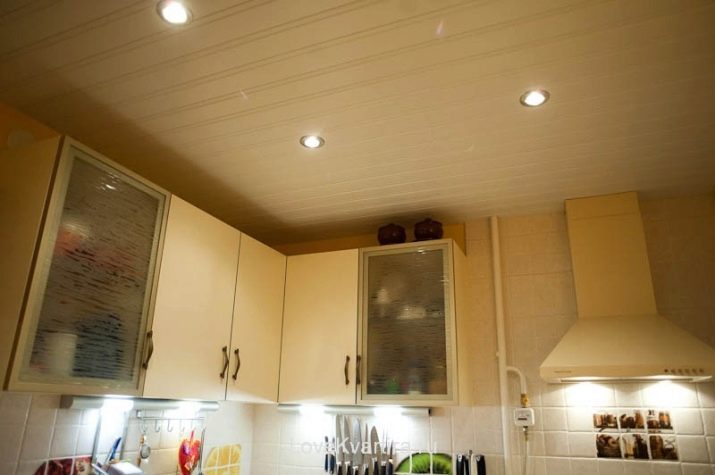
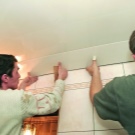
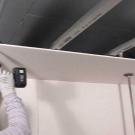

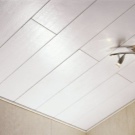
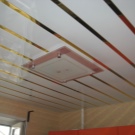
Along with a large number of undeniable advantages, there are still disadvantages of panel decoration. They include reducing the height of the room, as well as fading in the sun and the appearance of yellowness on plastic models. This ultimately leads to the loss of attractiveness of the ceiling and the need to replace it. Among the shortcomings, one can note the difficulty in caring for interpanel joints, which tend to accumulate fat and dirt in themselves.
In order to avoid such troubles, it is recommended to form seamless structures with very tight adjoining lamellas to each other.
However, the main disadvantage is the fact that The design of the ceiling with panels introduces some officeness and breech into the kitchen. This disadvantage can be mitigated only by careful selection of the color scheme and texture of the panels, as well as their maximum compatibility with the interior of the kitchen.
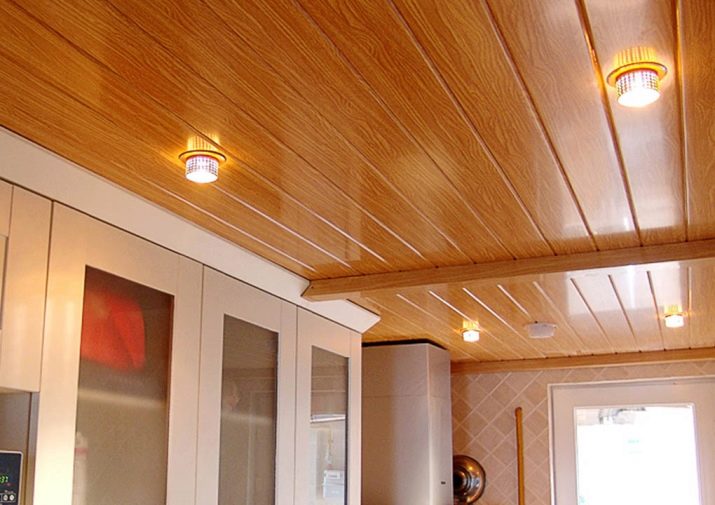
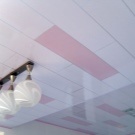
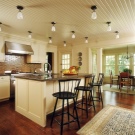
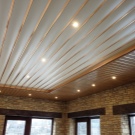
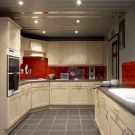
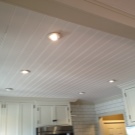
Kinds
The classification of panels for the ceiling is made according to several criteria, the main of which is the material for the manufacture of slats. According to this criterion, several varieties of coatings are distinguished: polyvinyl chloride and polystyrene panels, as well as models from MDF.
MDF
MDF panels are environmentally friendly and look very noble on the ceiling. Phenols are not used for their manufacture, and chip pressing is performed using the hot method. Such a ceiling can last more than one year, is easy to install and easy to maintain. MDF ceiling panels come in laminated, veneered and unprocessed (intended for painting). This diversity allows you to purchase material in accordance with the interior style and pick it up for kitchen furniture.
The disadvantages of MDF panels include high weight, flammability and low moisture resistance, which is why you can not see them in the kitchens as often as PVC models.
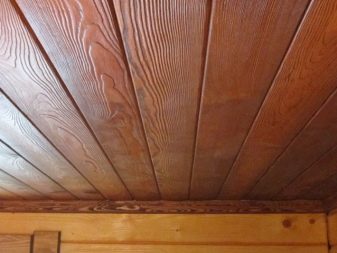
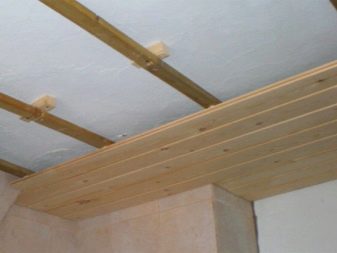
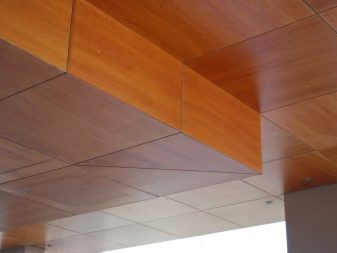
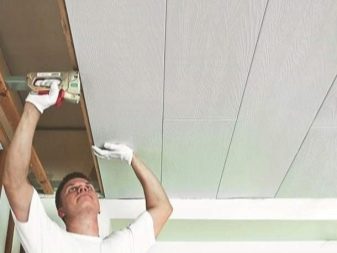
PVC
PVC lamellas are the most common option for finishing ceilings and are panels of various colors and textures. PVC lamellas are the leaders in popularity among finishing materials for the kitchen and have excellent working qualities: they do not fade in the sun, are antistatic, are not afraid of scratches and are highly decorative.
Their front side is often decorated with drawings, photo printing or laminated. This allows you to give the panels a picture of wood fibers, natural stone and other textures. The advantages of this coating are easy installation, moisture resistance and long service life. The minuses include a not too attractive appearance, which, according to most consumers, does not add comfort to the kitchen room.
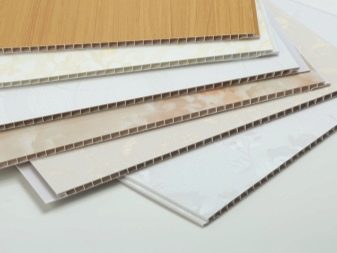

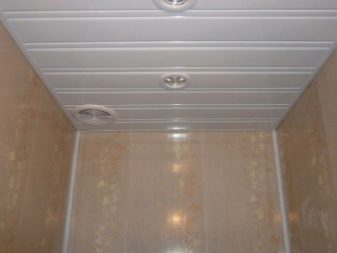
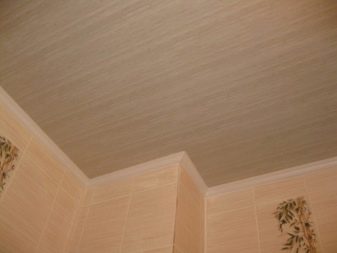
Expanded polystyrene
Expanded polystyrene panels are presented in the form of soft plates, which are the most budgetary option for the design of kitchen ceilings. The advantage of such a cladding is lack of the need for a frame since the plates are glued directly to the main ceiling. The minuses include a highly porous structure, which entails rapid contamination of the ceiling.
The way out will be the use of laminated foam panels, which have a smooth surface and are available in a wide variety of colors and textures.
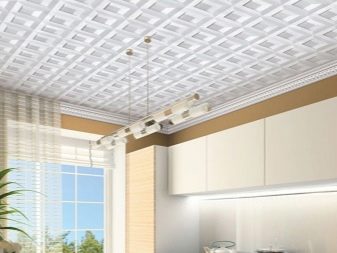
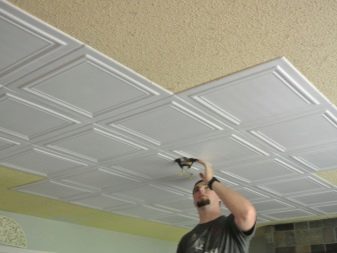
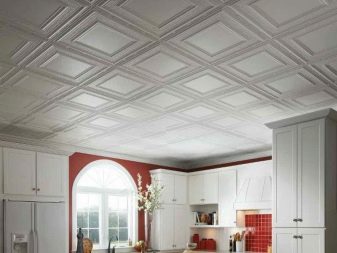
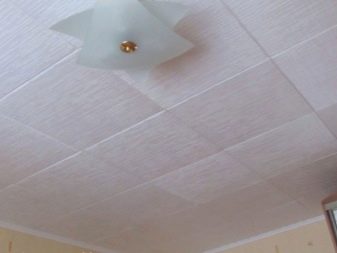
Another sign of the classification of panels for the ceiling is their size. The most convenient for installation are considered to be panels with a width of 10 to 12 cm and a thickness of up to 1 cm. The length is selected depending on the size of the room, sometimes from 1.5 to 3 m.
The panels differ in the type of connection. On this basis distinguish seamless patterns and lamellas having a chamfer (rust). For the ceiling structure in the kitchen, it is better to choose types without seams, the components of which are adjacent to each other as tightly as possible, forming an absolutely smooth surface. The panels of the second type are equipped with rust - a decorative recess necessary for connecting fragments into a common coating. Such a ceiling will be distinguished by a pronounced "strip", which not everyone likes.
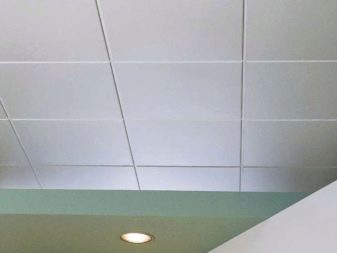
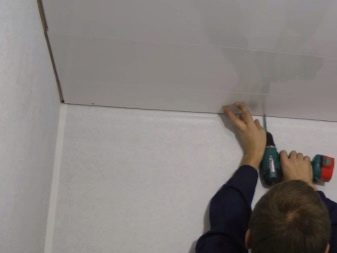
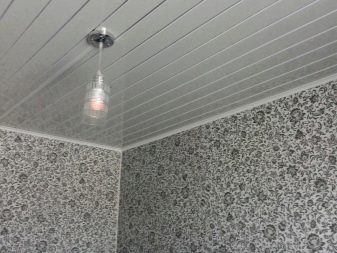
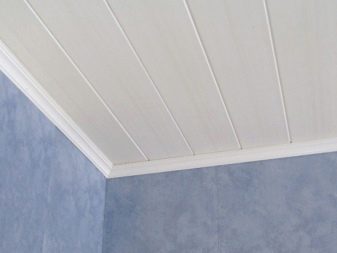
Design
The ceiling of the panels is not only a practical and inexpensive solution, but also allows you to realize the most daring design developments. The design of panel ceilings can be different and can be either single-level or multi-level designs with a direct or curvilinear design.
For the formation of elegant bends, PVC panels are used that bend well and do not break. Smooth surfaces are collected from MDF boards, which often have a pattern of wood fibers and are ideally suited to ethnic, rustic and ecological styles.
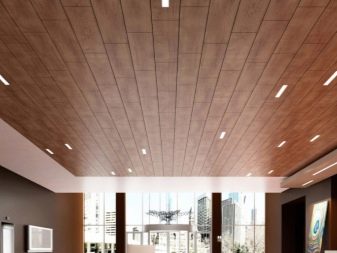
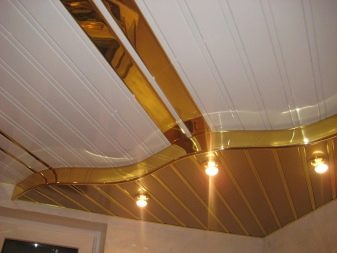
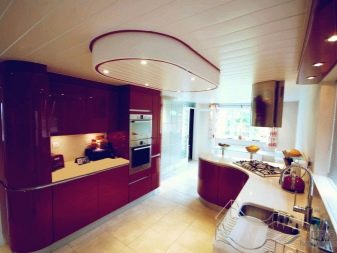
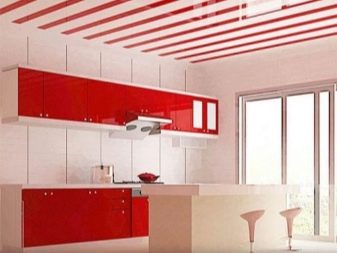
Despite the fact that such panels are available in a wide range of colors, far from any color is suitable for a kitchen ceiling. Designers recommend using materials in pastel colors. Such colors do not overload the top of the room and visually increase the space. Too dark shades visually lower the ceiling and make the room somewhat gloomy.
As for patterns and drawings, then when choosing them, you need to be especially careful and observe a sense of proportion. Too ornate lines make the ceiling heavy and oppressive, which is especially felt in small kitchens. For small spaces, only bright plain surfaces with invisible interpanel joints are acceptable.
The striped ceiling in small kitchens is also unacceptable. The same applies to 3D images that look good exclusively in spacious and tall rooms.
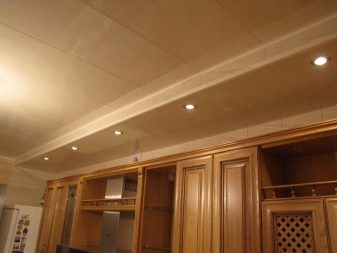
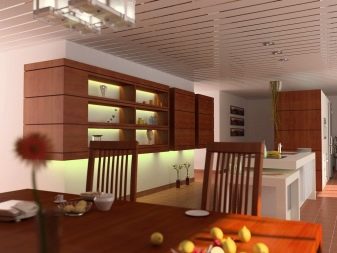
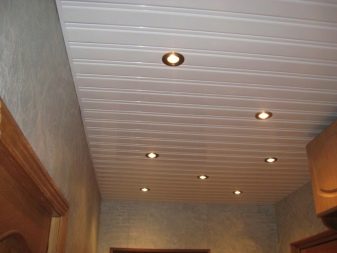

A kitchen with a low ceiling is well suited. surface with a slight mirror effect, which not only adds light to a low room, but also visually raises the ceiling.However, behind the beautiful appearance of glossy ceilings, serious flaws are also hidden. For example, oily drops and condensation are very clearly visible on the mirror surface, which are almost invisible on the matte panels.
The way out of this situation will be use of acrylic coated panels. Such models have excellent reflectivity and, in comparison with mirror ones, are much less easily soiled.
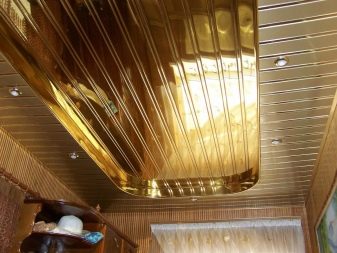
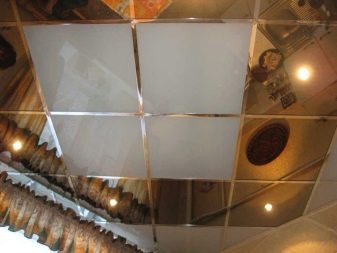

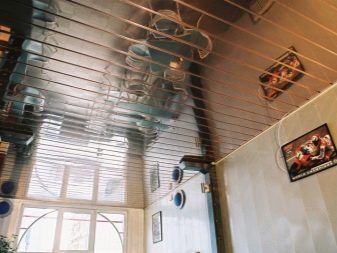
How to choose?
When choosing panels for the kitchen ceiling, you must rely on a number of recommendations.
- The panels should have the whole packaging and be perfectly flat. If chips and nicks are visible on the lamellas, then it is better to refuse to buy them. Firstly, defects will spoil the decorative appearance of the ceiling structure, and secondly, they will violate its integrity. In addition, painted panels should be stained evenly, not have stains and extraneous inclusions.

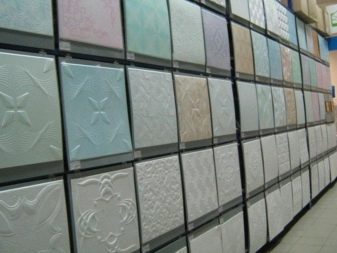
- The material for the manufacture of plastic panels must be flexible, but at the same time hard. Otherwise, there is a risk of getting a sagging thin ceiling or, conversely, to get poorly bending lamellas, which will be difficult to form from which a curvilinear structure. In order not to make a mistake in the choice, it is necessary to bend the outer layer of plastic and see if a crack or a whitish strip formed at the bend.
If one of these signs is found, it is better to refuse to buy panels from this batch. The presence of a white strip means that during the production process the proportion of chalk was significantly exceeded, the norm of which in plastic is not more than 20%.
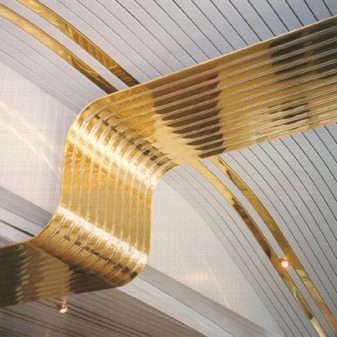
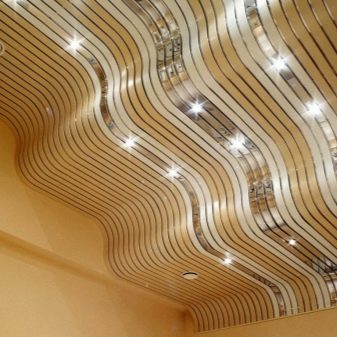
- If there are difficulties when choosing a color, then it is better to dwell on the white version. Such surfaces are suitable for all interior styles without exception and significantly refresh the space.
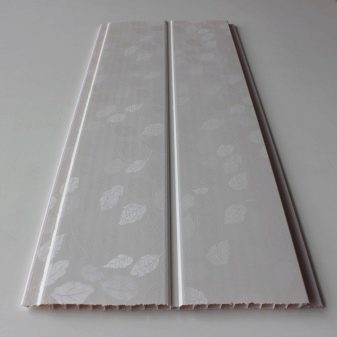
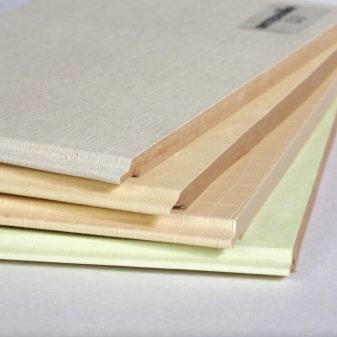
- When choosing panels from MDF with a wood pattern applied to them, you must make sure that all lamellas belong to the same batch. Otherwise, there is a risk of getting material in different shades, which will be noticeably especially good on the ceiling.
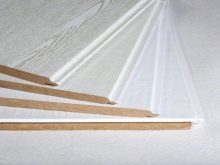
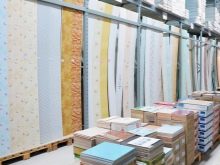
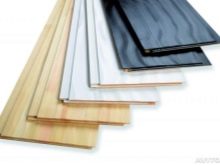
- When buying PVC panels, you need to pay attention to whether stiffening ribs appear on the front surface of the plate. If this fact takes place, then you do not need to buy such panels, since they will not look very aesthetically pleasing on the ceiling. In addition, if the distance between the stiffeners exceeds 1 cm, then such lamellas can become deformed and sag over time.
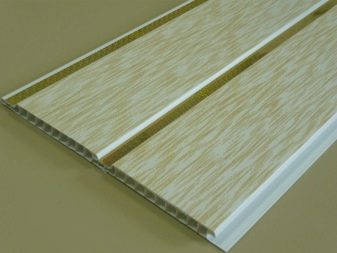
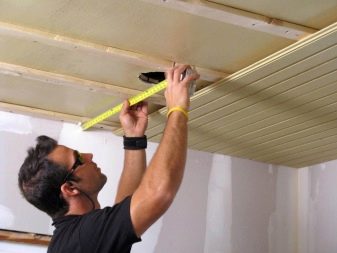
You should pay attention to the smell. This is especially true of plastic and expanded polystyrene products. To do this, you need to come up and smell the demo samples that have been on the trading floor for a long time. If they emit a persistent pungent smell of chemistry, then you do not need to buy such products.
Due to the wide variety of models, affordable cost, ease of maintenance and ease of installation, panels occupy high positions in the rating of finishing materials for the ceiling and make it possible to make the kitchen beautiful in a short time.
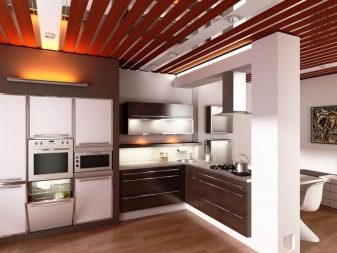
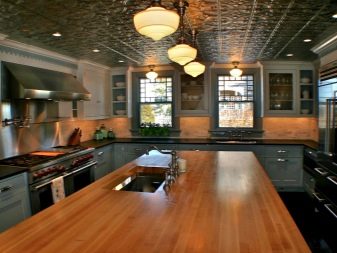
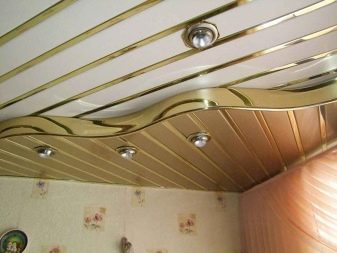
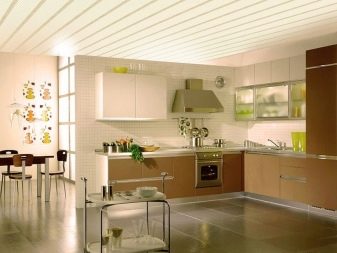
See the following video for the kitchen ceiling with PVC panels.
